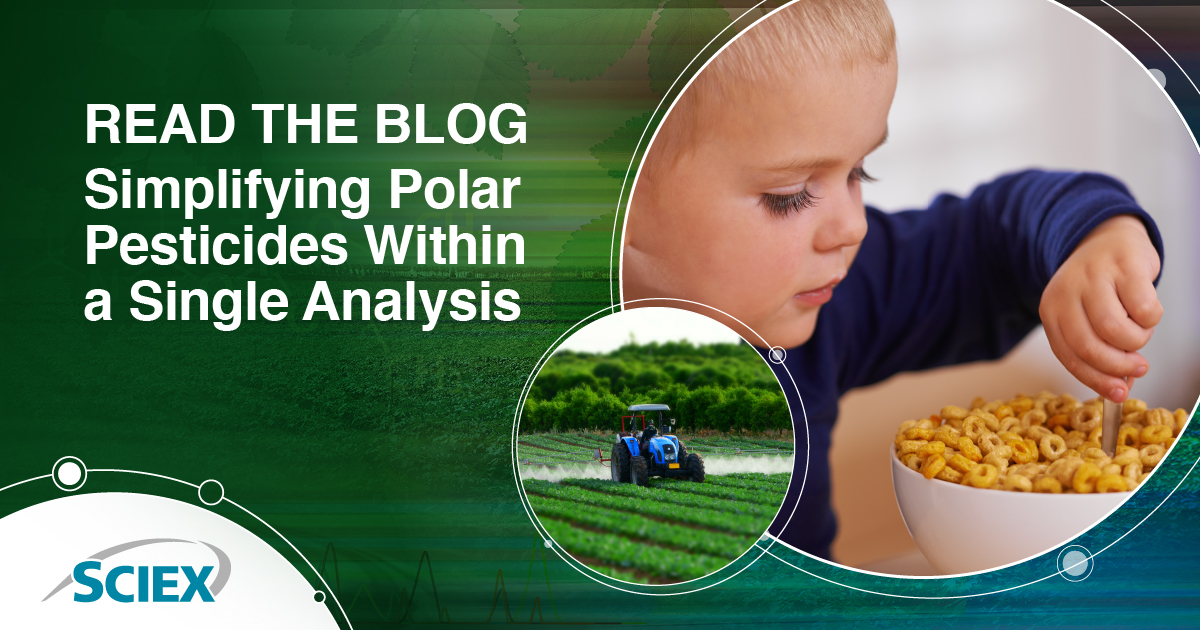Front-End Solutions for Lipid AnalysisWhich method should you choose? Lipids are a diverse group of compounds that serve many purposes. They are the basis for key biological entities including cell membranes, hormones, and lipoproteins and are involved in a variety...
Tags

6 Signs it’s time for a new vendor
A lab’s success depends on many factors from instrument quality to efficient operations, including being partnered with the right vendor. A vendor is more than just a supplier. They should provide you with a high-level quality of support in maximizing the lifespan and performance of your systems, reducing downtime, enhancing ROI and more. How do you know if you’re partnered with the right one? Here are six signs it might be time to find someone new.

Selecting an LC-MS system for quantitation of pharmaceutical drug development
We understand you are busy, needing to prioritize running instruments, reporting results and managing your laboratory to meet deadlines. We created a solution guide to explain how SCIEX systems fit in the drug development pipeline to save you time evaluating options.

Celebrating customer experience: Insights from SCIEX leaders
Introduction Customer Experience Day (CX Day) is a special occasion for SCIEX, celebrated every first Tuesday in October. It’s a day dedicated to recognizing the incredible value of our customers and the relentless dedication of our associates who strive to make...

PFAS analysis in food: a robustness study in sensitivity and stability
The combination of per- and polyfluoroalkyl substances (PFAS) testing, trace-level regulatory requirements and complex MS applications can be intimidating. In a recent webinar, now available on demand, SCIEX PFAS expert Craig Butt demonstrated how the new SCIEX 7500+ system can help make PFAS testing easier.

Your success and voice go a long way!
At the heart of everything we do is ensuring that your workflows and team are empowered to achieve optimal results with your SCIEX instruments, software, consumables, and services. Every interaction with SCIEX is designed to support your success through the dedication...

LC-MS system replacement: Are you ready?
Meeting deadlines in a bioanalysis laboratory can be a big challenge. Older, less sensitive and less reliable LC-MS systems make it even more difficult. Even the disruption caused by the installation and validation can be disconcerting and delay decisions. Does this sound familiar?

Understanding technical debt: the hidden cost of ignoring problems
In today’s rapidly evolving technological landscape, businesses heavily rely on software and IT systems to drive their operations. However, the pursuit of efficiency and speed often leads to the accumulation of what is known as technical debt. Technical debt refers to the implied cost incurred when businesses choose quick but limited solutions over better approaches that may take more time to implement. This blog post will delve into the concept of technical debt, its implications for businesses and how to avoid falling victim to its detrimental effects.
Optimized rolling collision energy curves for IDA and SWATH DIA for peptides
During data dependent acquisition (DDA or IDA) or SWATH acquisition, the collision energy can be automatically adjusted according to the mass/charge and charge of the peptide. This dependency has been well characterized on our QTOF systems. By selecting rolling...

Rescheduling a Schedule I substance, and the Delta-8 controversy
Did you know that in the US, drugs and other chemicals are classified into 5 distinct categories depending on the drug’s acceptable medical use and its potential for abuse or dependency? Drugs federally classified as Schedule I substances by the US Drug Enforcement Administration (DEA) are considered to have the highest potential for abuse and for creating severe psychological and/or physical dependence. In addition to heroin, LSD and MDMA (ecstasy), cannabis is classified as a Schedule I substance in the Controlled Substance Act of 1970, which means it has no approved medical usage.
sMRM Pro Builder template tutorial
The sMRM Pro Builder template is an Excel-based tool that can help you implement large panels of analytes in your lab. The Excel sheet will take your preliminary experimental results and compute retention times, retention time window widths and dwell time weighting to optimize your targeted assay.

Out with the “If it Ain’t Broke, Don’t Fix it” Approach. In with Remote Monitoring.
Often by the time you’re aware of a problem, it’s too late, and disaster has already struck. You’re forced to pick up the pieces—downtime, reduced productivity and lost data. When your PC goes down, IT comes to the rescue. That’s a reactive approach. In many cases, IT...

Increase your Lab’s ROI with Remote Monitoring Service for SCIEX LC-MS Systems
Like most organizations, your lab is likely thinking about ways to reduce costs and maximize profits.If so, keep in mind that no matter your area of research, sample volume or locations, remote monitoring services can make a difference in yearly maintenance...

SWATH Acquisition: A Step Closer to Unravelling the Opioid Puzzle
Drug overdose has become one of the leading causes of death of Americans under 50. If that’s not bad enough, let’s put this into perspective. America makes up only 4% of the world population. In 2015, it recorded 52,400 drug-related deaths, which is about 27% of the...

Greater uptime equals higher productivity
In the old days, if you wanted to monitor your lab’s data, you would either remain by your instrument as long as it took to complete the sample run or dial-in via a telephone modem. Neither option, however, offered much in the way of enhancing productivity. Today’s...

Simplifying Polar Pesticides Within a Single Analysis
Glyphosate is a polar pesticide widely used as a garden herbicide. It is an ingredient in the world’s bestselling weed killer, which farmers consider one of their best solutions to their super weed problems. However, the chemical has become one of the most...

5 Applications That Benefit from a New Dimension in Selectivity
Mass spectrometry can provide exceptional sensitivity, selectivity, resolution, throughput, and mass accuracy, but certain applications demand additional levels of selectivity. This is where differential ion mobility technology comes in. It delivers highly-selective,...

Screening Food for Allergens Using LC-MS/MS Analysis
Browse the shelves of any grocery store, and you may get a false sense of security when it comes to ingredient lists. As much as consumers want to trust labels, the truth is, food products could contain mislabelled ingredients, such that they trigger an allergic reaction with serious detrimental effects including discomfort, pain sickness and in some instances, death. Manufacturers, however, do not want to risk their reputation and consumer safety over a false label. As such, there must be some sort of verification to support such an action

4 Reasons Why Your Lab Needs Remote Monitoring
You know the drill, lab managers are always seeking new solutions to keep their labs running at peak performance and instrument or system disruptions can be detrimental. Wouldn’t it be nice if there were a way to connect to your lab from anywhere securely and to stay ahead of potential instrument problems? By using remote monitoring, labs are now able to respond to issues quickly and efficiently, productively reducing downtime.

Testing for a Variety of Bath Salts is a Necessity for Forensic Labs
To date, when it comes to testing urine or oral fluids in the workplace not all psychoactive substances can be detected due to evolving substitutions. As legislation changes, so too do chemical formulations. Therefore researchers, like the authors of the following publication, A Validated Method for the Detection of 32 Bath Salts in Oral Fluids, published by Oxford Academic, analyze compounds using the best available methods so they can cast a wider net.
Empowering Your Lab with a Proactive Approach
Do you stay in the lab day and night, waiting for a sample run to finish? Or do you set your instrument to run and trust that it will operate as intended while you are away? Is there a way you can have a support network behind you to help to ensure the smooth operation of your instruments?

Vitamin D Analysis Made Simple
Last month, Dr. Phil Levy, a clinician, professor, and researcher at Wayne State University, was invited to SCIEX to lecture on ‘Vitamin D Measurement and Implications for Patient Care.’ His message was simple and very clear: Vitamin D testing is here to stay!

What does World Food Day Mean to Food Scientists?
Did you know that the Food and Agricultural Organization of the United Nations (FAO), celebrates its founding each year on October 16 with World Food Day? You can explore their theme and commitment to ending hunger by 2030 here. As part of their, “Ten Facts You Need to Know about Hunger,” perhaps you may find it interesting that, “The world will need to grow 60 percent more food by 2050 to feed the growing population.”

Transform the Analytical Power of Your SCIEX Mass Spec with SelexION Technology
If you are working with complex assays that demand exceptionally selective quantitative and qualitative performance, sometimes even the most powerful LC-MS/MS technology can’t always cut it alone.

Fipronil Contamination in Eggs Update
Since my last blog, there has been an ongoing investigation into the widespread impact of contaminated egg products. According to The Grocer, 26 more egg foods were pulled from shelves in the fipronil scandal, bringing the total number to 69 products....

5 Ways That SelexION Technology Will Address Your Biggest Analytical Challenges
If you are a scientist working with complex assays, finding a way to significantly improve selectivity of detection could solve some of your biggest analytical headaches. Are we right? If so, then you are in the right place. If you are confronted with assay...

Why is Metabolomics Important and How is it Enabling Precision Medicine?
Why is metabolomics important?
Metabolomics is the large-scale study of metabolites in biofluids, tissue extracts, or organisms. Metabolites are small (<1000 Da), biologically active molecules such as glucose, cholesterol, creatinine, hormones, lipids, and more.

Training Program for Today’s Food and Beverage Testing Lab
Is your lab looking to acquire methods for food testing? What about getting better acquainted on the SCIEX Triple Quad™ or QTRAP® mass spectrometers to learn quantitation better? The following SCIEXUniversity Success Program training courses not only cover food and beverage quantitation but offer application training on topics such as meat speciation testing and pesticide analysis. Especially important considering the latest Fipronil contamination in eggs.I want to sign up for courses >

Phthalates Are Out, Accurate Detection Using LC-MS/MS Technology Is In
Whether you like it or not, the plastics industry is a growing market. According to an Allied Market Research report, it was valued at $15,179 million in 2015 and is projected to reach $18,538 million by 2022, growing at a CAGR of 2.9% from 2016 to 20221. Additionally, according to the report, in 2015, phthalates type held two-thirds of the global market in 2015. An important statistic since the use of various phthalates is restricted in many countries because of health concerns2.

Forensics Made Easy
Mass spectrometry techniques are now commonplace for high throughput quantitation and screening, but also for research and discovery for food safety, forensics, environmental testing, and a host of other applications. The demands of these settings are different from traditional research, requiring MS systems which combine robust and reliable operation with straightforward day-to-day processing. The SCIEX X500R QTOF System has been developed specifically to meet these needs and is now helping to streamline the workflow of Zurich’s Institute of Forensic Medicine.

3 Workflows Designed to Accelerate Your Biologics Characterization
Biopharmaceutical development is booming and now an integral part of many pharmaceutical company pipelines. While these emerging biologics present exciting opportunities for the industry, their sophistication is challenging the limits of characterization at all stages of discovery and development.